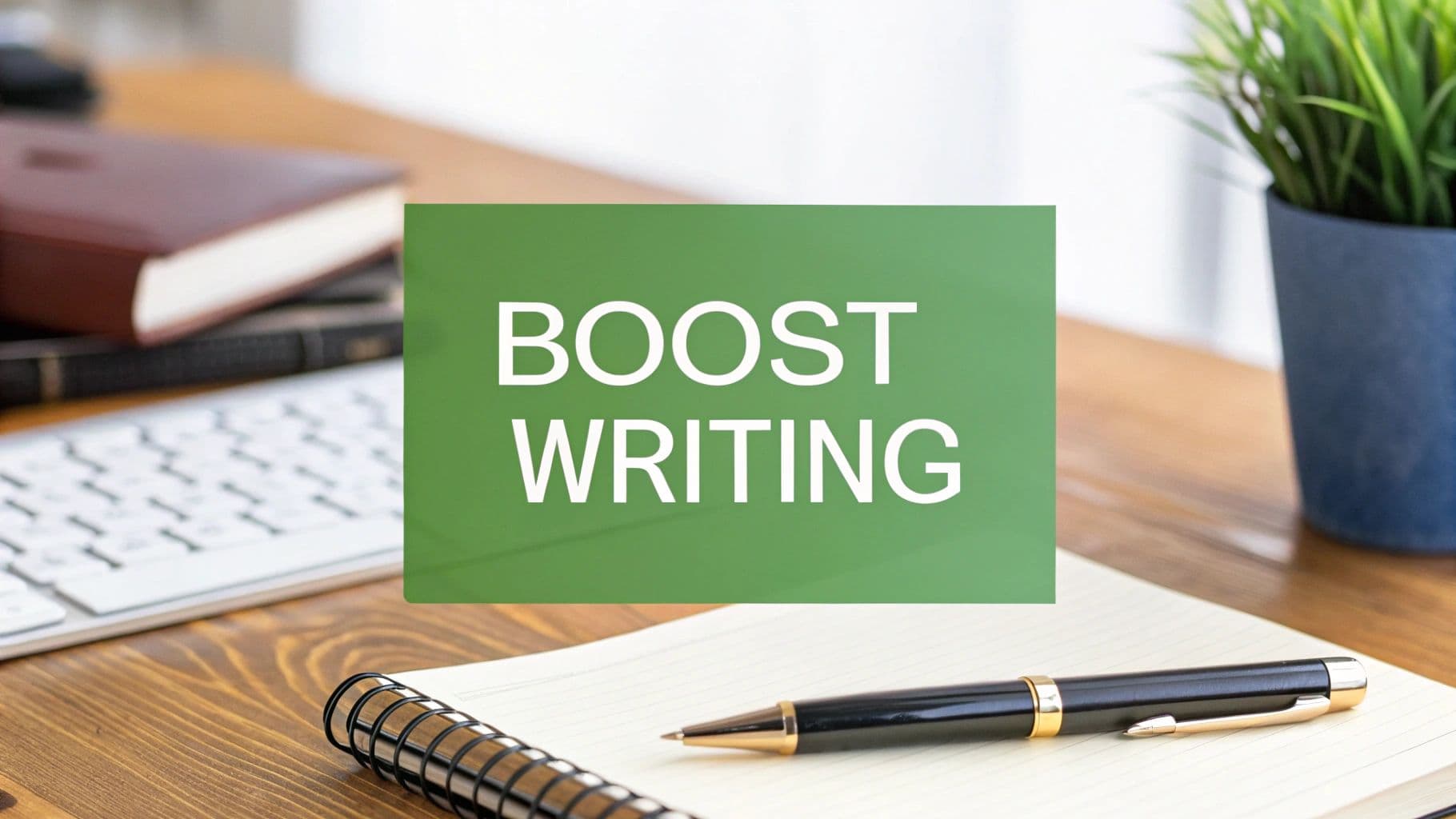
Boost Your Writing: Top Tips to Improve Writing Skills in 2025
June 10, 2025
Unleash Your Inner Wordsmith: Mastering the Art of Writing
Want to improve writing skills? This listicle delivers seven powerful techniques to elevate your writing in 2025, whether you're crafting academic papers, marketing materials, blog content, or social media posts. From daily writing habits to advanced revision systems, these strategies provide a roadmap for writers of all levels. Learn how to master grammar, refine your style, and unlock your writing potential. Strong writing is crucial for effective communication and success—let's get started.
1. The Daily Writing Habit
Want to improve writing skills? One of the most effective, yet often overlooked, methods is cultivating a daily writing habit. This isn't about churning out perfect prose every day; it's about consistent practice. Think of it like exercising a muscle: the more you use it, the stronger it becomes. By setting aside time each day to write, regardless of topic or quality, you build writing stamina, develop fluency, and reduce the dreaded writer's block. This consistent practice helps establish a natural writing rhythm and makes the process feel less like a chore and more like a reflex. This approach emphasizes consistency over perfection, focusing on building the habit first and refining the output later.

The core principle of the daily writing habit is simple: write something, anything, every single day. This could be journaling, freewriting, drafting blog posts, working on fiction, composing emails, or even just jotting down random thoughts. The content itself is less important than the act of writing itself. This consistent engagement with the written word is what truly hones your skills. Whether you're a student crafting academic papers, a marketer polishing ad copy, a blogger refining AI-generated drafts, or a freelancer perfecting client projects, a daily writing habit offers tangible benefits. It's a powerful tool for anyone seeking to improve writing skills, regardless of their current level or specific writing goals.
Examples of successful implementation of this method abound. Author Julia Cameron popularized "Morning Pages" in her book The Artist's Way, encouraging writers to fill three pages with stream-of-consciousness writing first thing upon waking. Participants in National Novel Writing Month (NaNoWriMo) commit to writing 1,667 words daily for the entire month of November. Even comedian Jerry Seinfeld famously uses the "Don't Break the Chain" calendar method to maintain his daily joke-writing streak. Professional journalists often have daily word count quotas to meet, further emphasizing the importance of consistent practice. These examples demonstrate the power of routine and the impact it can have on improving writing skills across various disciplines.
Adopting a daily writing habit doesn't require a Herculean effort. Start small, perhaps with just 15-20 minutes each day. Consistency is key. Writing at the same time each day helps solidify the routine and makes it easier to stick with it. Avoid editing or judging your writing during these sessions; the goal is to generate words, not perfect them. A simple notebook or a basic word processor can minimize distractions. Tracking your writing streak, perhaps with a calendar or app, can also boost motivation. These practical tips make the process less daunting and help establish a sustainable writing habit.
While the benefits are numerous, it’s important to acknowledge the potential drawbacks. Initially, the daily writing habit can feel overwhelming or even burdensome. If approached too rigidly, it can lead to burnout. The emphasis on quantity might, at times, overshadow the importance of quality. And, of course, maintaining a daily writing habit requires a significant time commitment. However, by starting small, focusing on consistency, and adjusting the routine as needed, you can mitigate these potential downsides and reap the long-term rewards of improved writing skills.
The daily writing habit deserves its place on any list of ways to improve writing skills because it addresses the core of effective writing: practice. It's not a quick fix or a magic bullet, but rather a sustained effort that yields substantial results over time. By consistently engaging with the written word, you develop fluency, reduce writer's block, and build a writing routine that becomes as automatic as brushing your teeth. Whether you're a student, a professional, or simply someone who enjoys writing, cultivating this habit can significantly enhance your ability to communicate effectively and express yourself with clarity and confidence.
2. Active Reading and Literary Analysis
Active reading and literary analysis is a powerful technique for improving writing skills that goes beyond simply enjoying a good book. It involves a strategic and deliberate approach to reading, where the focus shifts from passive consumption to active deconstruction. Instead of simply absorbing the story, you engage with the text as a writer, dissecting the author's craft to understand how they achieve their effects. This method allows you to "reverse-engineer" effective writing, uncovering the mechanics behind compelling prose, vivid descriptions, and engaging narratives. By studying how accomplished authors structure their sentences, choose their words, and build their arguments, you gain valuable insights that can directly enhance your own writing. This process isn't about plagiarism; it's about developing a deeper understanding of the tools and techniques that make writing effective.

This approach deserves a prominent place on any list aiming to improve writing skills because it provides a concrete and practical path to improvement. It moves beyond general advice and offers a tangible method for studying and replicating successful writing strategies. By actively analyzing the work of others, you build a repertoire of techniques you can consciously apply to your own writing, accelerating your progress and refining your style. Specifically, it involves close reading with attention to various craft elements: analyzing sentence structure, word choice, and rhythm, studying narrative techniques and organizational patterns, and consciously imitating and adapting successful techniques.
Consider Benjamin Franklin's famous exercise where he meticulously copied essays from The Spectator, then attempted to recreate them from memory, striving to match the original style and structure. This method, though centuries old, remains a powerful tool for internalizing effective writing techniques. Modern examples include writers studying Hemingway's concise dialogue techniques, poets analyzing the meter and imagery in classic sonnets, and business writers dissecting successful copywriting campaigns to understand their persuasive strategies. These diverse examples highlight the versatility of this approach, demonstrating its applicability across various genres and writing styles.
Active reading and literary analysis offers several key advantages: expanding vocabulary and exposure to varied writing styles, developing critical thinking and analytical skills, providing concrete models for improvement, enhancing understanding of genre conventions, and building an intuitive sense of what works in writing. However, it’s important to be aware of the potential drawbacks. This method can be time-consuming, and initial progress may feel slow. There's also a risk of over-imitating and hindering the development of your personal voice. Furthermore, comparing your work to that of established authors can create unrealistic expectations and lead to discouragement. Finally, this approach requires a certain level of analytical skill to be truly effective.
To maximize the benefits of active reading and literary analysis, consider the following tips:
- Read work that's slightly above your current skill level: This will challenge you without being overwhelming.
- Keep a writer's notebook: Jot down interesting phrases, effective sentence structures, and any other techniques that catch your eye.
- Rewrite passages in your own style: This helps you understand the underlying structure and experiment with different approaches.
- Focus on one craft element at a time: Instead of trying to absorb everything at once, concentrate on a specific area like dialogue, description, or pacing.
- Join or form a book club focused on craft discussion: Sharing your observations and insights with others can deepen your understanding and provide valuable feedback.
Whether you're a student refining an academic paper, a marketing professional crafting compelling copy, or a blogger enhancing the readability of AI-generated drafts, active reading and literary analysis offers a valuable pathway to improving your writing skills. By studying the masters and consciously applying their techniques, you can transform your writing from adequate to exceptional.
3. Structured Feedback and Workshopping
One of the most effective ways to improve writing skills is through structured feedback and workshopping. This collaborative approach involves sharing your work in progress with a group or mentor, receiving specific, constructive feedback, and also providing critiques to others. This dual process not only hones your writing but also sharpens your editorial eye, leading to a more comprehensive understanding of effective communication. This method goes beyond simple proofreading; it delves into the core of your writing, examining elements like structure, clarity, voice, and impact.

Structured feedback and workshopping thrive on established protocols. Regular submission of work for group review ensures consistent practice and progress. Critique sessions are typically guided by specific questions and focus on both the content (ideas, arguments, narrative) and craft (sentence structure, word choice, style) of the piece. This comprehensive approach allows writers to identify both macro-level issues, such as plot holes or unclear arguments, and micro-level issues, such as awkward phrasing or repetitive vocabulary. The environment cultivated in these sessions should be safe and encouraging, promoting experimentation and risk-taking without fear of harsh judgment. This fosters growth and allows writers to push their creative boundaries.
The benefits of this method are manifold. It provides an objective outside perspective on your work, often revealing blind spots you might have missed. Critiquing others' work, in turn, develops critical reading and editing skills, making you a more discerning writer and editor of your own work. The regular submission schedule inherent in most workshops creates accountability and motivation, encouraging consistent writing habits. Furthermore, workshopping fosters a sense of community and builds professional networks, offering valuable connections and support systems. Finally, exposure to diverse writing styles and approaches broadens your own creative horizons and expands your understanding of the craft.
This approach is particularly valuable for students and academics refining assignments and papers, allowing them to receive constructive criticism before submitting final drafts. Marketing professionals and copywriters can use workshops to optimize campaign content, ensuring it resonates with the target audience. Content writers and bloggers can enhance the readability of AI drafts by workshopping them with human editors, adding a layer of nuance and creativity. Freelancers and independent editors can benefit from the peer review aspect, gaining valuable feedback and refining their editing skills. Social media managers and digital marketers can leverage workshopping to humanize promotional copy, making it more engaging and less robotic.
However, structured feedback and workshopping also present some potential downsides. The quality of feedback depends heavily on the skills and experience of the group members. For beginning writers, the process can be intimidating, particularly if the group dynamics are not supportive. Conflicting advice from multiple sources can also be confusing and counterproductive. If not managed well, the focus on critique can sometimes stifle creativity, particularly if the feedback is overly critical or focuses too heavily on convention. Finally, participating in workshops requires a significant time commitment beyond just writing.
Examples of successful implementations include MFA creative writing workshops in universities, online communities like Critique Circle and Scribophile, local writing groups meeting in libraries and coffee shops, professional writer's organizations with critique programs, and beta reader programs in genre fiction communities.
To maximize the benefits of workshopping, consider these tips: Establish clear guidelines for constructive criticism to ensure feedback is specific and actionable rather than general or vague. Learn to separate your ego from your work when receiving critiques, viewing feedback as an opportunity for growth rather than a personal attack. Ask specific questions about areas where you want feedback to guide your reviewers. Finally, thank your critics and consider all feedback, even if you don't ultimately incorporate every suggestion. The process of thoughtful consideration itself is valuable for developing critical thinking skills. By following these guidelines and embracing the collaborative spirit of workshopping, you can significantly improve your writing skills and develop a deeper understanding of the craft.
4. Grammar and Mechanics Mastery
Want to improve writing skills? Grammar and mechanics mastery is an essential foundation. This strategy emphasizes developing a robust command of language fundamentals, including grammar, punctuation, sentence structure, and style conventions. Mastering these technical aspects provides the solid bedrock necessary for clear communication and compelling creative expression. It’s like building a house: you need a strong foundation before you can add the stylish décor. Without it, your writing, however creative, risks crumbling under the weight of errors and inconsistencies.
This approach involves systematic study of grammar rules and their exceptions, not just a superficial understanding. It means actively practicing with varied sentence structures and complexities, moving beyond simple subject-verb-object constructions. It also encompasses understanding how punctuation contributes not just to clarity, but also to creating specific effects in your writing, like building suspense or emphasizing a point. Finally, familiarity with style guides, like the AP Stylebook for journalists or APA/MLA for academics, equips you to navigate different writing contexts professionally.
Consider the journalist meticulously following AP Stylebook conventions to ensure consistency and accuracy in their reporting, or the academic writer adhering to APA or MLA formatting to meet scholarly standards. A marketing professional crafting compelling copy will understand the subtle impact of punctuation on the reader's emotional response. Content writers and bloggers, especially those working with AI-generated drafts, will benefit greatly from strong grammar skills to refine and humanize the output. Similarly, freelance editors and independent writers rely on these skills to ensure their work is polished and professional. Even social media managers aiming to connect with their audience benefit from a command of grammar and mechanics to ensure their message is clear and credible. These examples demonstrate the wide-ranging applicability of grammar and mechanics mastery across diverse writing disciplines.
One of the key features of this approach is error pattern recognition and correction. By consciously identifying your recurring mistakes, you can target specific areas for improvement and make significant strides in your overall writing quality. This is particularly helpful for students refining assignments and papers, as well as for marketing professionals and copywriters optimizing campaign content.
The benefits of grammar and mechanics mastery are multifaceted. It builds confidence in your technical writing ability, allowing you to focus on expressing your ideas rather than worrying about basic errors. It elevates the clarity and professionalism of all your writing, making your work more accessible and impactful. This mastery significantly reduces editing time in later drafts, freeing you up to concentrate on higher-level revisions and refinements. Furthermore, a solid grasp of grammar enables you to construct more sophisticated and nuanced sentences, enriching your writing style and enhancing your credibility with readers.
However, like any approach, this method has its potential drawbacks. Focusing on grammar can feel dry and academic compared to the excitement of creative work. It can sometimes lead to an over-emphasis on rules at the expense of developing a unique voice and style. Remember, rules are there to guide you, not to stifle your creativity. Grammar rules can also be complex and, at times, appear contradictory, requiring patience and persistence to master thoroughly. Additionally, this focus on technical accuracy might initially inhibit the flow of writing during the drafting stage. It’s important to find a balance between adhering to rules and allowing your ideas to flow freely.
To effectively implement this strategy, consider these actionable tips: Use grammar checkers as learning tools, not as crutches. Instead of blindly accepting corrections, take the time to understand the underlying grammatical principles. Read grammar rules in context rather than relying on isolated examples. This will help you grasp the nuances of language and apply the rules appropriately. Practice identifying your most common error patterns, then focus on mastering one grammar concept at a time before moving on to the next. Most importantly, apply new rules immediately in your regular writing practice to solidify your understanding and integrate them into your writing habits.
Learn more about Grammar and Mechanics Mastery
Authors like Strunk and White ( The Elements of Style ), William Zinsser ( On Writing Well ), Bryan Garner ( Modern English Usage ), and Patricia O'Conner ( Woe Is I ) have popularized and championed the importance of mastering grammar and mechanics for effective writing. Their works offer invaluable resources for anyone seeking to improve their writing skills. By dedicating time and effort to mastering these foundational elements, you empower yourself to communicate with greater clarity, precision, and impact. This, in turn, strengthens your writing, making it more compelling, persuasive, and ultimately, more effective in achieving its intended purpose.
5. Genre-Specific Technique Development
Want to improve writing skills effectively? Consider genre-specific technique development. This targeted approach focuses on mastering the conventions, techniques, and reader expectations within a particular writing genre. Instead of relying on general writing advice, it encourages a deep dive into the nuances of specific forms, whether it's crafting a compelling mystery novel, penning a persuasive essay, creating clear technical documentation, or composing evocative poetry. This method allows you to hone your skills in a focused manner, leading to noticeable improvements in your chosen area of writing.
This strategy rests on understanding that different genres demand different approaches. A romance novel thrives on emotional connection and character arc, while a technical manual prioritizes clarity and precision. Genre-specific technique development recognizes these distinctions and provides a framework for developing the skills specific to your chosen form. This approach is particularly valuable when you aim to improve writing skills for a specific purpose, such as publishing a novel, writing effective marketing copy, or crafting compelling academic papers.
This method involves several key features: deep study of genre conventions and reader expectations; practice with genre-specific techniques and structures, such as plot outlines for mysteries or sonnet forms for poetry; understanding of market demands and publication standards within the genre; development of an appropriate voice and style for the genre, from the hard-boiled prose of detective fiction to the lyrical language of nature writing; and knowledge of successful examples and influential works within the genre.
The benefits of this approach are numerous. It provides a clear framework and expectations to work within, making the sometimes daunting task of improving your writing feel more manageable. It develops marketable skills for specific writing opportunities, increasing your chances of success in your chosen field. By building expertise within a specific genre, you can open doors to professional opportunities, whether that's landing a publishing deal, securing a technical writing position, or getting your screenplay noticed. Furthermore, it allows you to create focused improvement goals, leading to faster and more noticeable progress. Finally, it connects you with specific reader communities, enabling you to understand their preferences and tailor your writing accordingly.
However, like any approach, genre-specific technique development also has its drawbacks. Focusing intensely on one genre may limit your versatility across different writing types. Adhering too rigidly to genre conventions can make your writing formulaic and predictable. Remember that genre conventions evolve over time, so staying current is crucial. This approach may not develop fundamental writing skills as broadly as a more general approach. Finally, there's the risk of “writing to genre,” prioritizing adherence to conventions over authentic expression.
Let’s look at some examples of genre-specific technique development in action. Romance writers might study the intricacies of character arc and relationship development, paying close attention to the emotional beats that resonate with readers. Technical writers, on the other hand, focus on mastering clear instruction and documentation formats, ensuring that information is presented accurately and accessibly. Screenwriters delve into the three-act structure and the nuances of dialogue formatting, learning how to craft compelling scenes and engaging characters. Business writers concentrate on developing persuasive proposal and report structures, employing language that is both professional and impactful. Poets immerse themselves in the study of form, meter, and contemporary verse techniques, exploring the possibilities of language and imagery.
If you’re looking to improve writing skills within a specific genre, here are some actionable tips: Read extensively in your chosen genre, paying attention to both classic and contemporary works, including recent publications. Study successful examples to understand what makes them effective. Analyze the work of influential figures within your genre, such as Syd Field for screenwriting structure, Donald Maass for fiction writing techniques, Ann Handley for content marketing, or Stephen King for horror and suspense. Understand your target audience's expectations and preferences. Join genre-specific writing communities and organizations to connect with other writers and learn from their experiences. Seek guidance from editors and agents who work in your chosen genre.
By embracing genre-specific technique development, you can gain a deeper understanding of the nuances of your chosen form and develop the skills necessary to excel within it. This targeted approach allows you to improve writing skills effectively and efficiently, paving the way for success in your chosen field. While it's important to be mindful of the potential drawbacks, the benefits of focused practice and genre expertise can significantly enhance your writing abilities and open up new opportunities.
6. Revision and Self-Editing Systems: Polishing Your Prose to Perfection
Want to improve writing skills? Mastering revision and self-editing is crucial. This methodical approach emphasizes rewriting as much as the initial drafting process. It involves developing systematic approaches to reviewing, revising, and polishing your written work through multiple passes, each focusing on different aspects such as structure, clarity, style, and mechanics. It's about transforming a rough draft into a polished piece, ready to captivate your audience. This system is invaluable for anyone looking to improve writing skills, from students crafting academic papers to marketing professionals fine-tuning campaign content.
A robust revision and self-editing system relies on multiple targeted passes. This multi-layered approach allows you to focus on specific elements in each stage, preventing you from feeling overwhelmed and ensuring a more comprehensive edit. First, you might tackle the big-picture elements: structure, argumentation, and overall flow. Are your ideas presented logically? Does your narrative arc make sense? This stage is where you might make significant cuts, additions, or reorganizations of content. Next, you'll dive into the details, focusing on clarity and style. Is your language precise and engaging? Have you varied your sentence structure to avoid monotony? Finally, you'll perform a close reading, hunting for grammatical errors, typos, and inconsistencies in mechanics. This meticulous approach ensures that your final product is polished and professional.
The benefits of implementing such a system are manifold. It dramatically improves the final quality of your written work, leading to clearer communication and a stronger impact on your readers. It also develops critical thinking and problem-solving skills as you learn to identify and rectify weaknesses in your writing. You'll gain a deeper understanding of what makes writing effective, enabling you to apply these principles to future projects. Moreover, a strong self-editing practice creates independence from external editors, saving you time and resources. Finally, this system is universally applicable, regardless of the type or length of your writing, whether it's a concise social media post or a lengthy research paper.
However, like any system, revision and self-editing have potential drawbacks. It can be time-consuming, potentially delaying project completion. There's also the risk of over-editing, leading to a loss of your original voice or energy. Maintaining objectivity about your own work can be challenging, and sometimes, the pursuit of perfection can become a trap, preventing you from ever truly finishing. Finally, multiple rounds of revision require discipline and dedication.
Numerous successful writers and editors have championed the importance of revision. Ernest Hemingway famously revised the ending of A Farewell to Arms 39 times. Journalists use the inverted pyramid style of editing to ensure the most important information is presented first, allowing for easy trimming if necessary. Academic writers rely on peer review and multiple drafts to refine their arguments and ensure clarity. Bloggers often employ multiple editing passes, focusing first on content and then on copy editing for grammar and mechanics. Authors such as William Zinsser (On Writing Well), Sol Stein (Stein on Writing), Renni Browne and Dave King (Self-Editing for Fiction Writers), and Susan Bell (The Artful Edit) have popularized various revision techniques. Learn more about Revision and Self-Editing Systems.
The following infographic illustrates the three-stage revision and self-editing workflow, outlining the key steps for refining your writing.

This infographic visually represents a sequential three-stage process for revision and self-editing. The linear progression emphasizes the importance of completing each stage before moving on to the next, ensuring that structural issues are addressed before fine-tuning the style and mechanics.
Here are some actionable tips to improve writing skills through effective revision and self-editing: Let your work "cool" between writing and revision sessions to gain a fresh perspective. Focus on big-picture issues like structure and argumentation before diving into line-level editing. Read your work aloud to catch rhythm and flow problems. Use different locations or formats for revision (print versus screen). Finally, develop personalized checklists for common areas needing improvement in your writing. By incorporating these techniques into your writing process, you can significantly enhance the quality and impact of your work.
7. Writing Prompts and Creative Exercises
Looking to improve writing skills? One highly effective technique involves regular engagement with writing prompts and creative exercises. This practice-based strategy offers structured activities and imaginative prompts, allowing you to explore new writing territories, conquer writer's block, and hone specific skills. Whether you're a student refining an academic paper, a marketer crafting compelling ad copy, or a blogger seeking to elevate your content, writing prompts offer a versatile pathway to improvement.
This approach provides guided practice opportunities that push you beyond your comfort zone. From crafting micro-fiction to tackling long-form narratives, these exercises offer diverse challenges designed to cultivate versatility, creativity, and technical proficiency. Imagine navigating a constraint-based prompt that limits you to a specific word count or forces you to incorporate unusual vocabulary. Or perhaps you're inspired by an open-ended prompt that invites you to explore a particular theme or emotion. Regardless of the format, these targeted exercises provide the focused practice necessary to refine your writing abilities.
Structured exercises often target specific skills like dialogue writing, descriptive language, or plot development. For instance, a prompt might challenge you to write a scene where two characters argue using only subtext. This focused practice allows you to isolate and improve individual aspects of your writing. Conversely, creative prompts are designed to spark inspiration and overcome the dreaded writer's block. A prompt like "Write a story about a world where gravity works in reverse" can unlock unexpected creativity and lead to fresh narratives.
Several key features distinguish this approach. The structured exercises offer tailored practice for specific skills, while the creative prompts ignite inspiration. The variety of formats caters to diverse writing styles and goals, accommodating everything from flash fiction to novel-length exercises. Progressive difficulty ensures you can systematically build your skills, starting with simpler challenges and gradually advancing to more complex ones. Finally, the combination of constraint-based and open-ended challenges offers a balanced approach, fostering both discipline and imaginative freedom.
The benefits are numerous. When inspiration is elusive, prompts provide a much-needed structure and direction. They cultivate versatility and expand your range as a writer by exposing you to different genres, styles, and perspectives. Successfully completing these challenges builds confidence and reinforces your writing abilities. They also offer a low-pressure environment for experimentation, allowing you to try new techniques and take risks without the fear of judgment. Furthermore, this approach can be tailored to individual needs and skill levels, making it accessible to writers of all backgrounds and experience levels.
However, like any method, writing prompts and creative exercises have potential drawbacks. Some writers might find the exercises artificial or disconnected from their "real" writing goals. The quality of the exercises can vary greatly depending on the source of the prompt, so careful selection is essential. There's also a risk of becoming overly reliant on external inspiration, potentially hindering the development of internal creative drive. Furthermore, the time dedicated to these exercises might be better spent working on larger, more substantial projects. Finally, certain exercises might not align with a writer’s specific interests or goals.
Numerous examples illustrate the effectiveness of this approach. The National Novel Writing Month (NaNoWriMo) daily writing challenges provide a structured framework for completing a novel draft. The Writer's Digest offers a wealth of creative writing prompts, spanning various genres and styles. The Poetry Foundation’s Poem-a-Day challenges encourage daily poetic exploration. Online communities like Reddit's WritingPrompts subreddit offer a constant stream of user-generated prompts, fostering a collaborative and supportive writing environment. Even traditional writing workshops often incorporate warm-up exercises and timed writes, utilizing prompts to jumpstart creativity and encourage spontaneous writing. Learn more about Writing Prompts and Creative Exercises to delve deeper into this technique.
To maximize the benefits of this approach, consider the following tips: Choose prompts that challenge you while remaining achievable. Set time limits to prevent overthinking and encourage a state of flow. Don’t get bogged down by concerns about quality; instead, prioritize completion and exploration. Feel free to combine multiple prompts or add your own constraints for an added layer of complexity. Finally, review your completed exercises to identify strengths, weaknesses, and recurring patterns in your writing.
Pioneered by influential figures like Natalie Goldberg (Writing Down the Bones exercises), The Writer’s Digest (prompt publications), and Julia Cameron (Artist's Way exercises), the use of writing prompts and creative exercises has become a staple in the writing community. This widespread adoption underscores the value and effectiveness of this approach for writers of all levels seeking to improve writing skills. From sparking inspiration to honing technical proficiency, writing prompts offer a powerful tool for anyone striving to enhance their writing craft.
7 Strategies for Improving Writing Skills
| Strategy | 🔄 Implementation Complexity | 🛠️ Resource Requirements | 📊 Expected Outcomes | 💡 Ideal Use Cases | ⭐ Key Advantages |
|---|---|---|---|---|---|
| The Daily Writing Habit | Low to Medium (requires daily discipline) | Time commitment (daily writing) | Improved fluency, writing stamina, reduced block | Building writing consistency and habit | Builds discipline, fluency, and raw content |
| Active Reading and Literary Analysis | Medium to High (analytical skill needed) | Access to varied texts, note-taking tools | Enhanced craft understanding, expanded vocabulary | Developing writer’s eye and technique mastery | Improves critical thinking and offers concrete models |
| Structured Feedback and Workshopping | Medium to High (group coordination required) | Writing group or mentor, regular submissions | Objective feedback, motivation, community building | Collaborative improvement and accountability | Provides diverse perspectives and develops editing skills |
| Grammar and Mechanics Mastery | Medium (systematic study required) | Grammar resources, style guides | Strong technical foundation, clarity, professionalism | Foundational writing skill improvement | Improves writing clarity and reduces editing time |
| Genre-Specific Technique Development | Medium (focused study and practice needed) | Genre-specific resources, community | Mastery of conventions, marketable skills | Targeted genre writing and professional growth | Builds expertise and clear framework for success |
| Revision and Self-Editing Systems | Medium to High (methodical, multi-pass process) | Checklists, editing tools, time | Significantly polished final drafts | Improving draft quality and independence | Dramatically improves quality and critical thinking |
| Writing Prompts and Creative Exercises | Low (structured but flexible) | Prompt sources, timed practice | Increased creativity, versatility, confidence | Overcoming writer’s block and skill-building | Encourages experimentation and creative flow |
Elevate Your Writing: From Good to Exceptional
Improving your writing skills is a continuous journey, and the seven strategies discussed—daily writing, active reading, feedback integration, grammar mastery, genre-specific techniques, revision systems, and creative exercises—offer a robust framework for improvement. From students and academics refining their papers to marketing professionals optimizing campaign content, honing these skills is essential for effective communication. Remember, consistent application of these techniques is key to seeing real growth. By actively incorporating these strategies, you’re not just improving your writing; you're enhancing your ability to connect, persuade, and inspire. Mastering these skills empowers you to craft compelling narratives, articulate complex ideas with clarity, and achieve your communication goals, whether it's landing a new client or captivating your audience.
These techniques provide a springboard for taking your writing from good to truly exceptional. The most significant takeaways include establishing a regular writing practice, engaging deeply with the work of others, embracing constructive criticism, and dedicating yourself to the ongoing process of revision and refinement. As you progress, explore tools and resources that can further enhance your writing journey.
Want to polish your prose and ensure a natural, human touch in your final drafts? Explore Natural Write, an AI-powered writing assistant that can help you refine your text and achieve a clear, concise, and engaging style. Visit Natural Write today and discover how this tool can assist you in elevating your writing to the next level.


